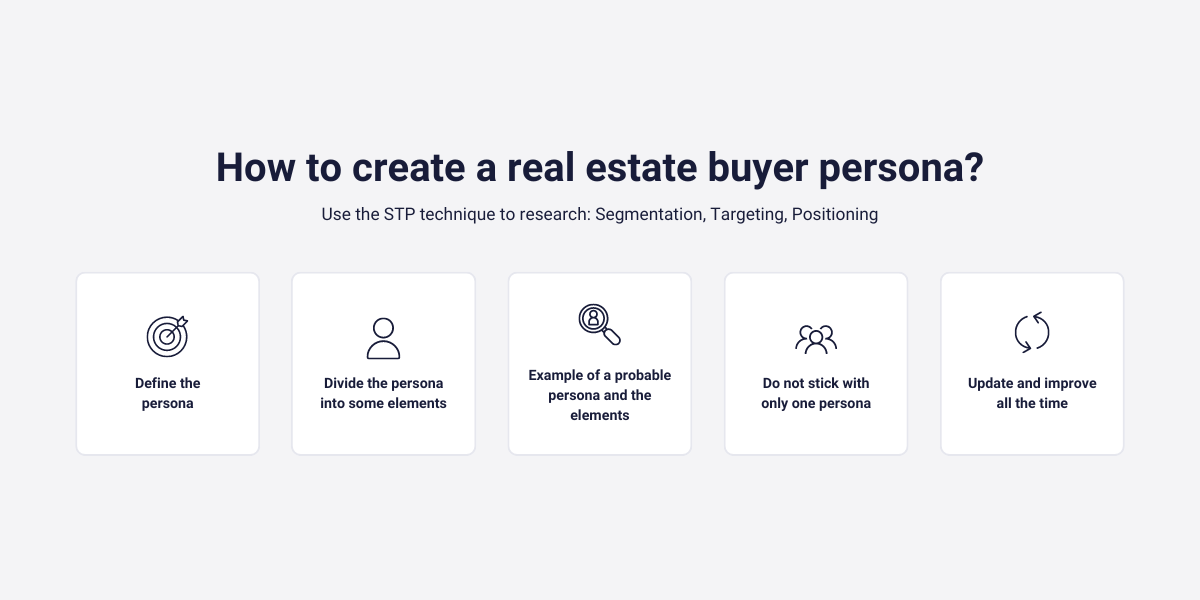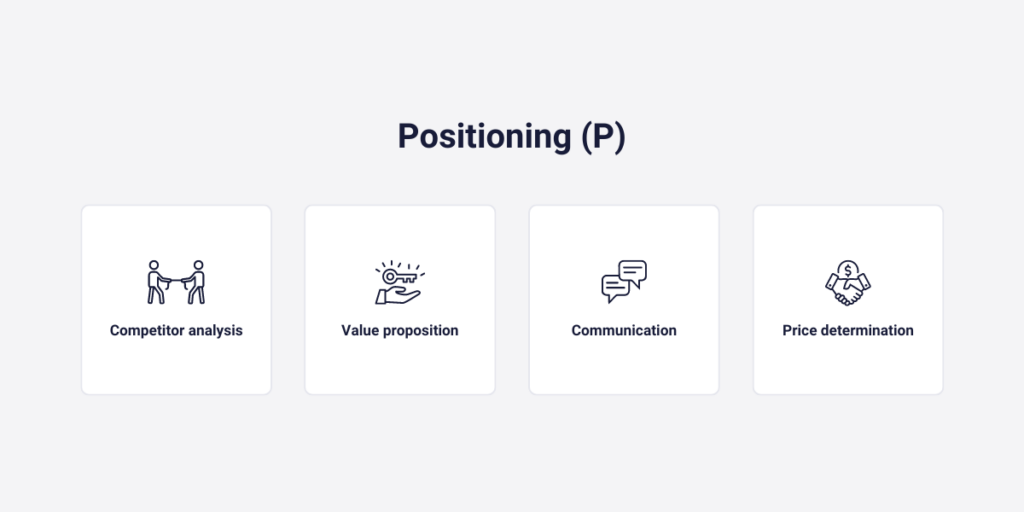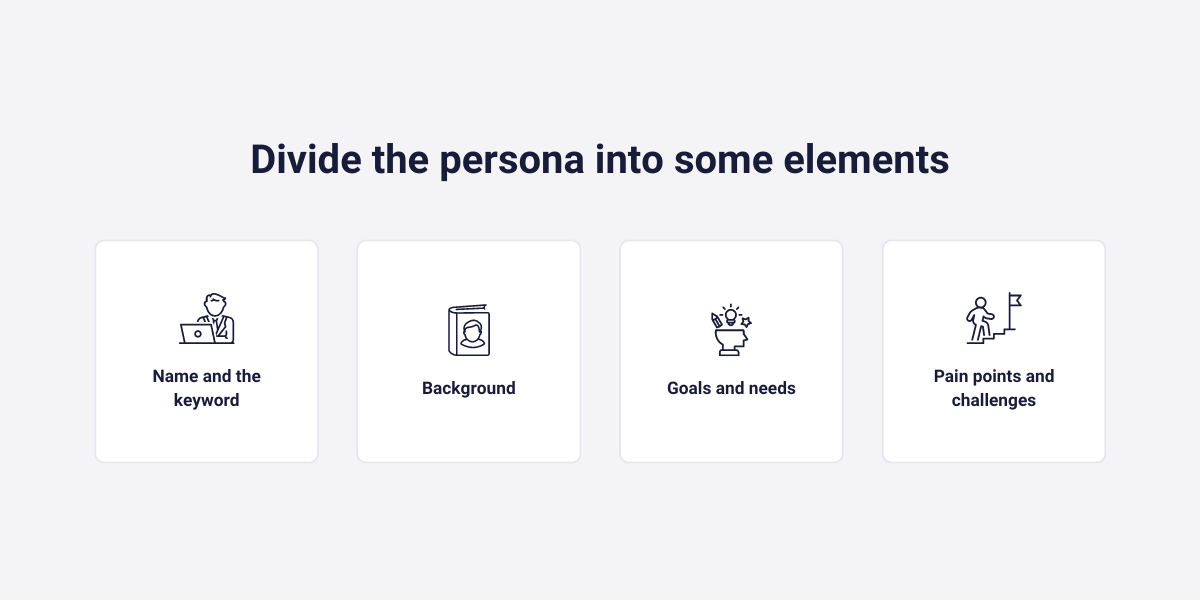The real estate market is rapidly growing. According to the Comerica Bank’s forecast, the national house prices will rise by 2.9% in America. Statista also made an in-depth analysis of this industry’s next couple of years, and it looks promising: the sector is anticipated to grow at an annual rate of 3.41% from 2024 to 2028!
These conclusions all lead to one way: the highly growing demand will attract new and new vendors in this industry. Also, old real estate websites may also think that it is time to expand. They want to spend more money than ever to attract new buyers because they know: it is their time to shine! It is the time to grow their market share! However, it is a highly resourceful industry. We think we don’t need to explain this to you.
That’s why, even if you are interested in customer acquisition, you want to save some money. The thing is: well-maintained buyer personas can let you do that. However, this marketing-typed involvement has some bumps, so you better take care. In this article, we will share the main steps of creating some real estate buyer personas. Since, even if it is a complex approach, it is still learnable. Learnable by minutes!
Table of Contents
What is a buyer persona?
First thing first, the definition of the buyer persona. Even if this technique is highly used in the marketing industry, that’s not the most important thing in creating a website and generating traffic.
“Buyer persona is basically a profile. A profile that illustrates your target audience. It should depict the characteristics of the chosen target audience, their behavior, or general information.”
A business usually works with many target audiences. These are a well-chosen group of people whom the business wants to sell the product or service. That being said, the business tailors its communication to attract the attention of those groups of people, find more clients, and gain more revenue in the end. However, establishing the target audiences is a hard, and slow process. It starts with market research, questionnaires, and interviews. After that, you can finally understand segments but still have no clue about the market capitalization. In short, it’s hard, and it’s full of unsure elements.

Why are these important?
Even if creating target audiences is hard, it’s still a necessity. When a business puts its own business in the first place, and the buyers to the second, it never ends up in a good manner. In the 21st century, people want tailored messages, more than ever. Buyers started to get rid of those companies who tried to target everyone for the purpose of achieving great profits. Because these can never give satisfaction to the customers. Companies focusing on CX increase their revenue by 80%. That was from Zipia’s research. And one way to make customer satisfaction or the customer experience better is by providing personalization.
Research conducted that 90% of leading marketers say personalization significantly contributes to business profitability. So you better know who your visitors are, and what they need for the perfect experience. A buyer persona can help you with that.
How can a buyer persona help with this?
A buyer persona helps you discover your target audience: that’s crystal clear by now. And if you know what they want, know how to attract their attention, and how to convince them to choose your site, you win the big prize.
When the visitors feel that you care about your target audience, and you appreciate their coming, they will be happier than ever. It may mean a lot of things:
- Visitors spend more time on your site
- Gain more click-through rates
- Healthier conversion funnels
- Less conversion funnel friction
Overall, a well-maintained buyer persona may be the key to your customer’s heart. In addition to that, focusing on buyer personas is essential in the real estate industry. In the next chapter, you will gain information about how to create a real estate buyer persona from the beginning to the very end.
How to create a real estate buyer persona?
Even if creating a buyer persona does not require too many steps, the preparation process or the measuring process can also require some time. In this part, we will not only cover the main parts of the buyer personas but the additional parts as well. Since without these additional parts, creating buyer personas worth nothing.

Things to do before the persona
Covers those steps that you need to do before actually creating the persona.
Use the STP technique to research!
Segmentation, targeting, positioning. These are the three crucial steps that STP covers, a marketing model that redefines whom you market your products, and how. Before you even want to sell your products to anyone, you need to be sure who your audience is. In this part, you need to segment your audience using some criteria.
1. Segmentation
In the segmentation part, you need to answer some questions first. These are:
- Where are you selling your products?
An important question for real estate businesses, as you can’t cover the whole map by selling products. You need to determine an area. Inside this area, the citizens get into your potential group of clients, and you need to forget those who are on the other side of the wall.
- What do you sell?
Interesting question, as even if it is trivial that you sell real estate, no matter what types of other services you offer, or how expensive are your products. For example, if you offer rent as well, covering the young might be a good option. In another case, if you only cover the premium segment, you might want to stick with middle-aged, or elderly people.
- How do they behave?
You need to discover where your potential audience can be found; both in the offline and the online world. What are their habits, what brands they like, and how often they purchase.
- Who are they?
The most in-person discovery. You need to find out their hobbies, interests, and their general lifestyle. If 50% of your potential buyers like fishing, you can send them targeted messages about real estates that are not far away from lakes, or seas.

After you answer these questions, you can group your potential buyers into multiple segments.
For example:
- A: 30-50-year-old traders who buy houses for reselling opportunities.
- B: 18-25 university students who are searching for cheap property rentals.
Of course, you need to differentiate these groups more from the others, and write more information about the given group of people. However, this was just an example for easier understanding.
2. Targeting
Let’s say, you differentiated 10 potential segments. The bad thing is: it is still a lot! There are not enough resources in the world to create personal messages for 10 different groups of people. So, you need to delete some. How? Based on some criteria!
- Size
If a group only contains 10 members, how can you ensure your profitability? There’s no chance! For this reason, it is important to target those groups that are big enough to be worth a shot.
- Difference
Your potential targeted groups need to be differentiated from each other. Imagine: you spend double money for one targeted group. Never ever do that!
- Reachability
A real estate business can’t reach children. That’s because under 18 (and some other year restrictions in other countries) you are not eligible to buy a house of your own. Under that age, you can’t simply sign legal agreements and complete real estate transactions. This factor covers all the legal and technical aspects which make targeting impossible for some segments.
- Profitability
The projected amount of money you can win from targeting the chosen segment. You need to measure their willingness to pay, customer acquisition cost, or return on investment.
- Benefits
The “A” segment only wants to buy real estate in rural areas, while the“B” segment prefers urban areas. You are selling three times more rural real estate, which segment do you prefer? Of course, “A”. You can attach many benefits from different groups that help you decide the ones you should choose over the others.

3. Positioning
This step is about your product and the way you present it to your potential customers.
You need a(n):
- Competitor analysis
To track how the market shares stand, and whether they have already taken care of your targeted groups.
- Value proposition
How can you be unique in this market?
- Established communication
What you will communicate to your potential buyers.
- Price determination
Low, medium, or high prices?

Here, you need to find those markets which none of your competitors use, or just in a small case. You also need to calculate that the potential revenue from the given markets at least covers your fixed and variable costs. If you find empty spaces, get ready to step into the market, and go to the buyer personas stage.
Steps of creating the buyer persona
Even if you find out who you are selling to, as we mentioned, personalized experience is important. Like, what if I tell you that by just using buyer personas, you can decrease the costs of customer acquisitions by 50%?
In this stage, we will discover the parts of creating an effective buyer persona!
1. Define the persona
“David, a 32-year-old American man, loves buying real estate. He buys 4 a year, for reselling options. His main prospects are near New York, with a maximum spending of $100,000 on each. David’s profession is valued, but he is also one of the best on the planet at what he does. He is quite confident but also likes high-pressure situations. He wants to find great investments and does not dare take the time to find the best deals. His goal is to generate some income from these transactions and make some complementary money to finance their kids’ university studies. He will use our site if the real estate agent’s commission rate is low, and if it takes less time to complete a deal than in our competitor’s site”.
This is a complex persona, but you can still add more information to it. Hobbies, general interests, goals, and so much more. This is your ideal customer “in-person”, and it can tell you so much more than defining target audiences. A defined target audience can conclude some characteristics of the given people, but a buyer persona knows some more. Predicting these groups’ future behavior!
2. Divide the persona into some elements
Of course, you can gain information from the persona if you just write down 10 sentences with the most crucial information. But in this case, you may miss some things later.

That’s why in the real estate industry, a persona appears with a pinpoint, and is separated into four elements:
- Name and the keyword
In this section, you create the persona’s name and the keyword(s) that determine the whole persona. Sometimes the name also refers to the activities, and the general information we want to display with the persona.
- Background
General information about the persona: wage, education, marriage status, age. Important, in order to put some other layers into the persona later.
- Goals and needs
In this section, you need to determine the goals and the needs of your persona with your real estate website. He requires a big space, a big garden, a rural area, a healthy atmosphere, decreasing CO2, and many others.
- Pain points and challenges
Challenges that the persona may face. Your task is to decrease these designated pain points, and convince them: there’s no better time than buying, or renting now!
Now let’s see an example, highlighting these four points!
3. Example of a probable persona and the elements
Name and the keyword:
- James Ford – the hard-working American
👤 Background:
- coming from a hard-working family in Ohio.
- Running through the university while constantly working on a blue-collar job.
- Finding a partner at 25, they spent the next five years together on a rent.
- Last year, he was promoted and today he has an annual salary of $100.000.
- They are having a child this year, and with three members of the family, they are starting to grow their rent capability.
- He constantly uses social media to do his work, and in his free time as well.
- This is the only way Ford searches for potential houses.
✅ Goals and needs:
- Ford wants to move to a bigger house than today’s, they even plan to have two more children.
- He doesn’t want to spend more than $500,000 on the house, as Ford declines long-term loans.
- His plan is to move to a rural area, but not far away from Columbus, where he works.
- He works from home at least free times a week, so a stable internet connection is critical.
❌ Pain points and Challenges:
- Working 6 days a week, Ford has no time to search for the best deal.
- The time is ticking: they need a new home before their son is born, which will be approximately 5 months from now.
- Ford has a fear about the constantly increasing inflation and real estate prices.
4. Do not stick with only one persona
The thing is, it is very rare that a real estate company’s buyers are the same. It is usually fragmented into many groups. They have:
- different financial situations
- unique preferences
- volatile shopping activity (some of them only want to buy 1 house in their whole life, some want to buy one from month to month).
That’s why it is essential to create at least 5 real estate buyer personas, but not more than 10. Otherwise, different buyer personas may cannibalize each other.
What does that mean?
It means that 2 or more personas are partly, or completely the same, and even though you spend 2 times more money to direct them to your website, you still reach the same number of people.
5. Update and improve all the time
It is a general misbelief that a buyer persona will be successful for the first time. It almost always needs continuous fixing and improvement. But a good question is: how can you check that you reach that segment that you wanted to get with your personas?
Well, even though you can partly check that on your social media sites, and those people who get engaged there. But the best way to analyze your success is on your website. However, first you need to add an online analytics tool to your site.
It is not rocket science to add one, here is a link for the proper installation process. After you are done with this, your visitors and their activity on your site are constantly monitored. Therefore, you can gain access to a lot of crucial data.

With Capturly Analytics, our online analytics tool, you can even get access to a segment heatmap function, which is unique across the market. With this segment heatmap function, you can analyze your visitors’ clicks and scrolls on your pages with the help of five segmenting options. These are:
- New vs returning
- Operating system
- Referrer
- Browser
- Device
If one of your buyer personas uses social media quite often, you can be sure that when you set “Instagram” as the referrer, those clicks and scrolls appear only that they made. With the help of this segmenting function, you can even get access to each of your buyer personas conversion funnels, rates, and friction ratios.
With the help of Capturly’s features, you can understand different buyer persona preferences, so this is also one of the best options for customer recovery for real estate websites.
Things to do after the persona
After establishing the personas, you have a lot of work to do in connection with them.
You need to tailor your strategies and operations to meet their specific needs and preferences. Changing your communications in social media, advertising in new ways and places, restructuring the brand values, or the website itself.
Let us share an example: if your buyer personas are very variable, based on the number of rooms they would want in a house, you better develop filtering on this specific aspect on your website. Also, if most of your buyer personas’ best color is blue, try to use it more often in your social media pics, and advertisements, or your website itself.
Conclusion
At the beginning of this article, we demonstrated STP, which is a very common marketing technique to find your target groups. Later, we introduced buyer personas, we also showed you:
- The relevance of it
- The elements of it
- Real estate buyer personas examples
At the end of the article, Capturly Analytics stepped into the picture that helps you analyze the success of your real estate buyer personas. Yes, you always need to monitor these personas to know what to change in your website, communication, values, or social media platforms.
Do not forget: the real estate market is expanding, but the number of competitors is also increasing continuously in this market. You need to be sure who you want to earn, and if that segment will be worth a try.
A real estate buyer persona is a semi-fictional representation of your ideal clients based on market research and real data about your existing customers.
Buyer personas help you understand your clients better, allowing you to tailor your marketing, communication, and property offerings to meet their specific needs.
The main elements are:
– Name and the keyword
– Background
– Goals and needs
– Pain points and challenges
The general agreement is: create at least 5, but no more than 10!
Buyer personas can be measured with conversion rate, customer acquisition cost, or engagement rates. If you want to measure your buyer personas’ success on your website, we recommend you try Capturly Analytics and its unique function: the segment heatmap!
Don't forget, sharing is caring! :)

![How to Create Real Estate Buyer Personas [Examples]](https://capturly.com/blog/wp-content/uploads/2024/06/How-to-Create-Real-Estate-Buyer-Personas-Examples-1.png)